Chapter 7 Photosynthesis: The Light Reactions

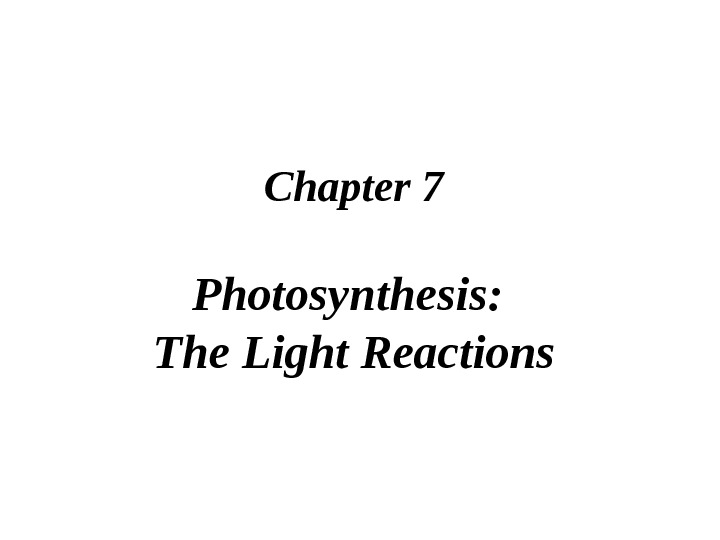

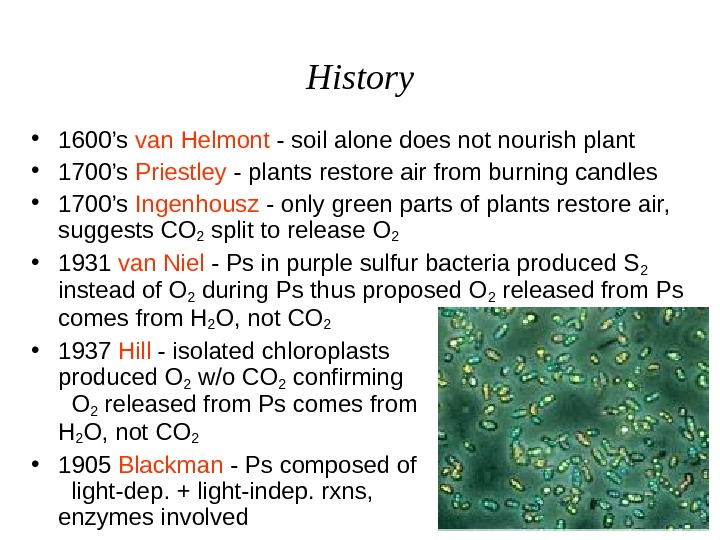

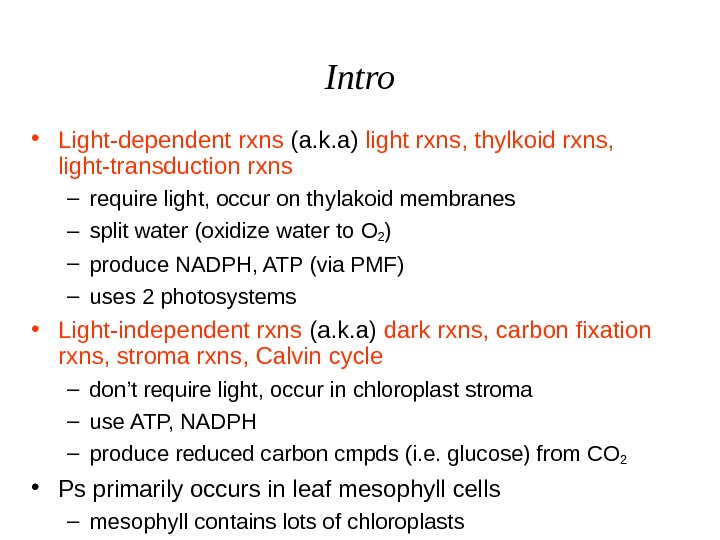
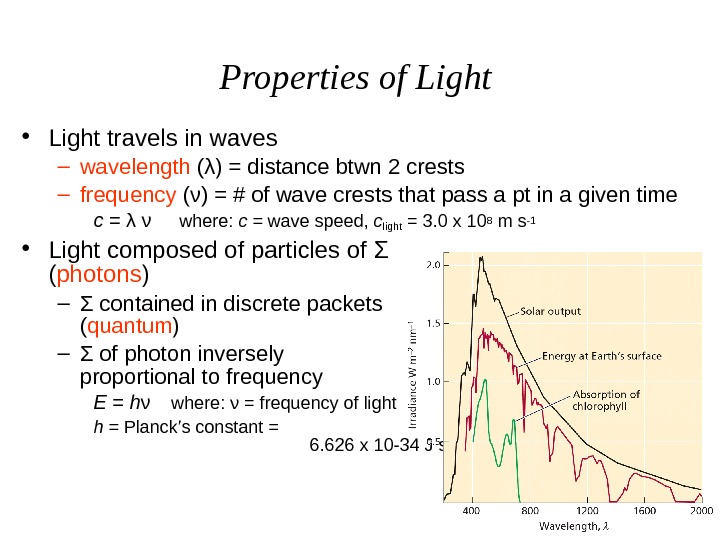

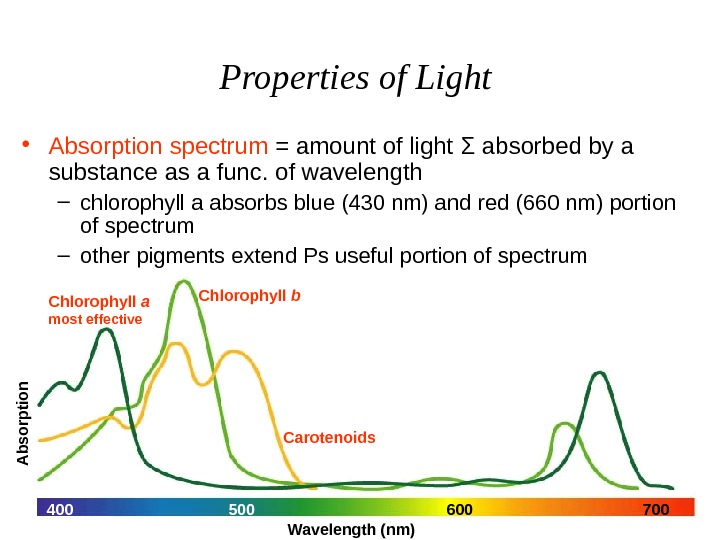

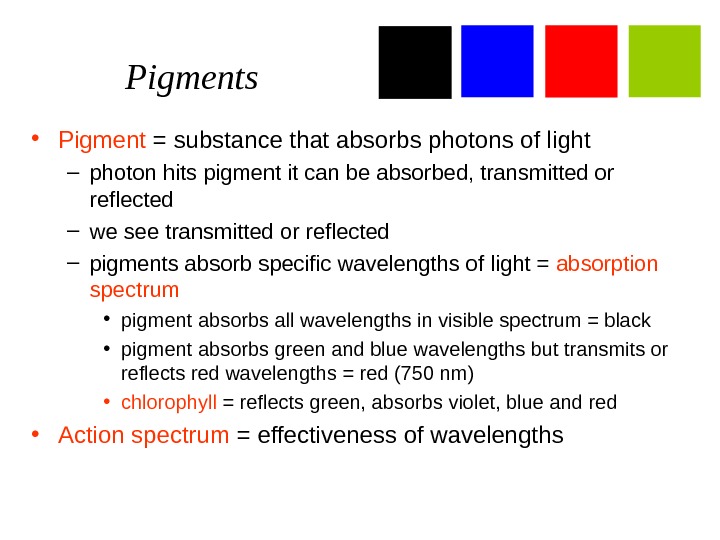
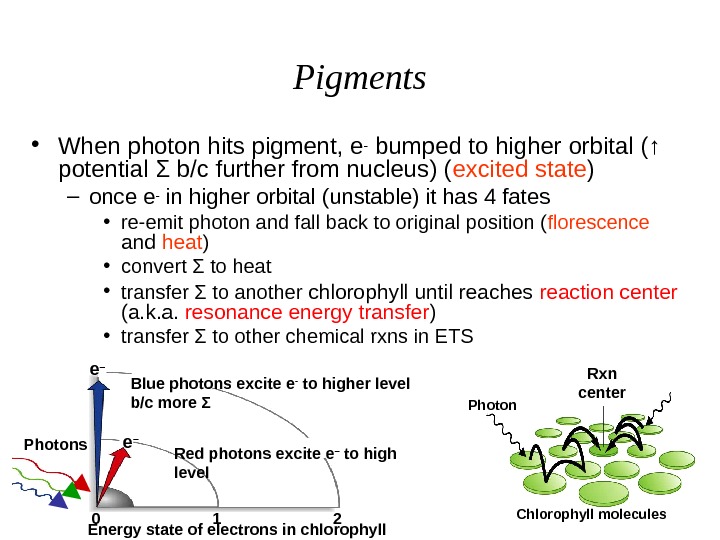
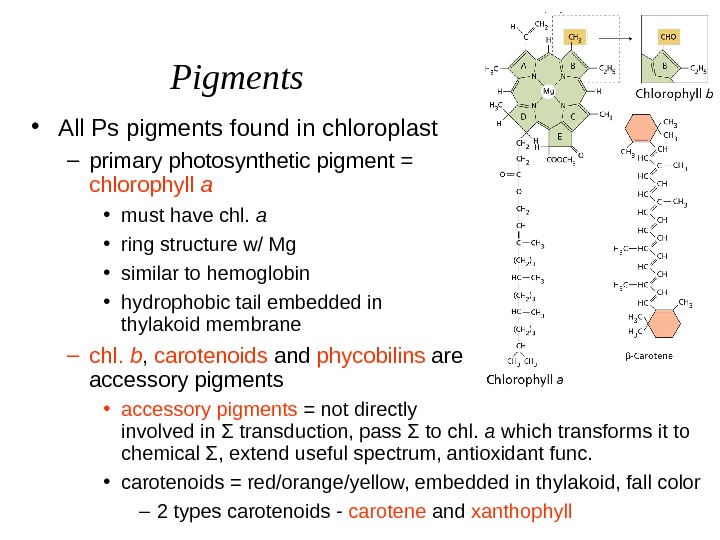
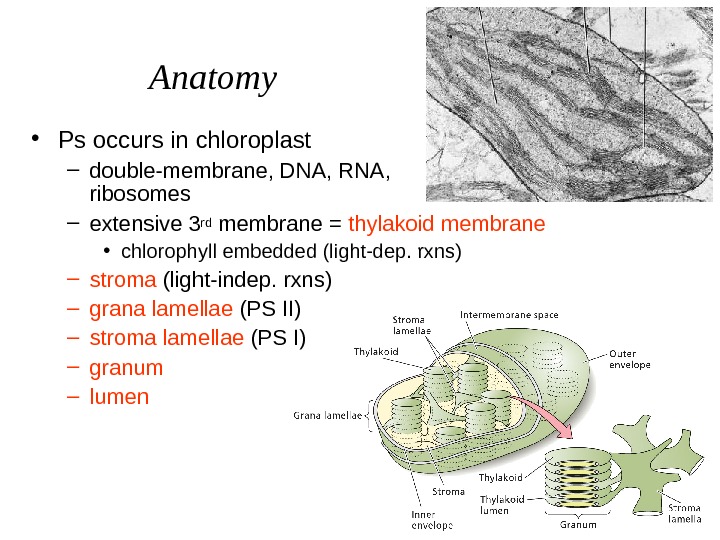

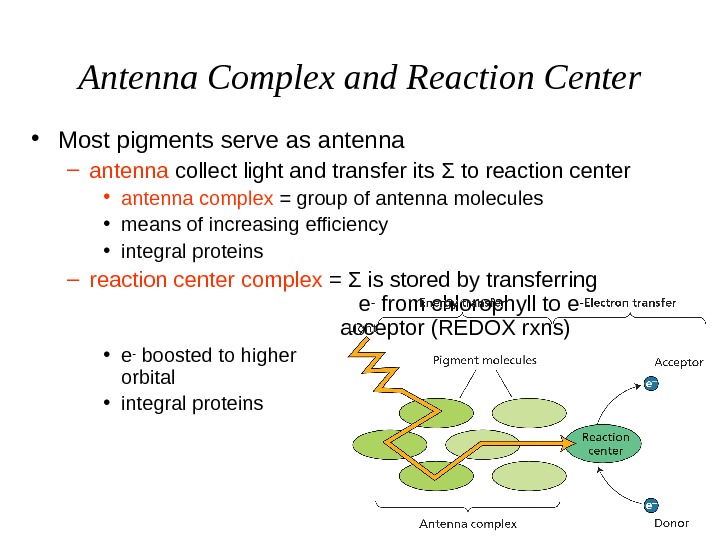

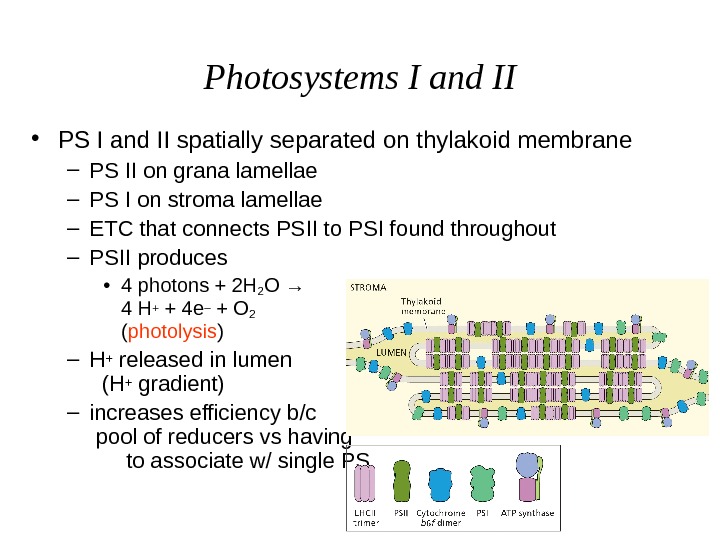
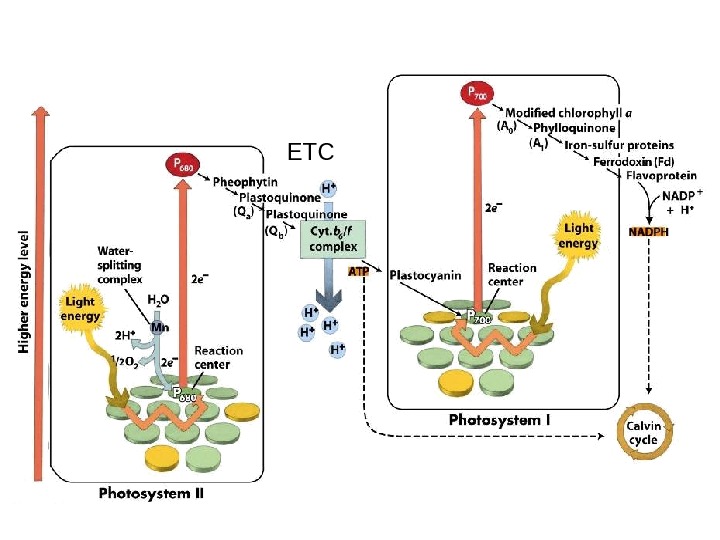
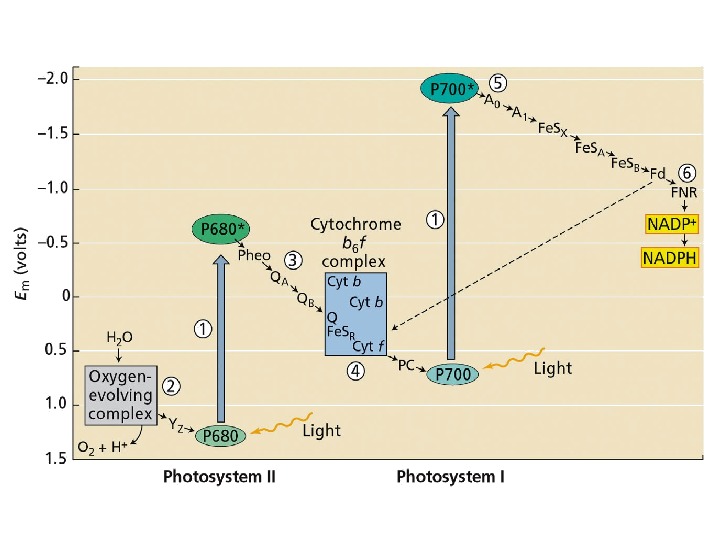
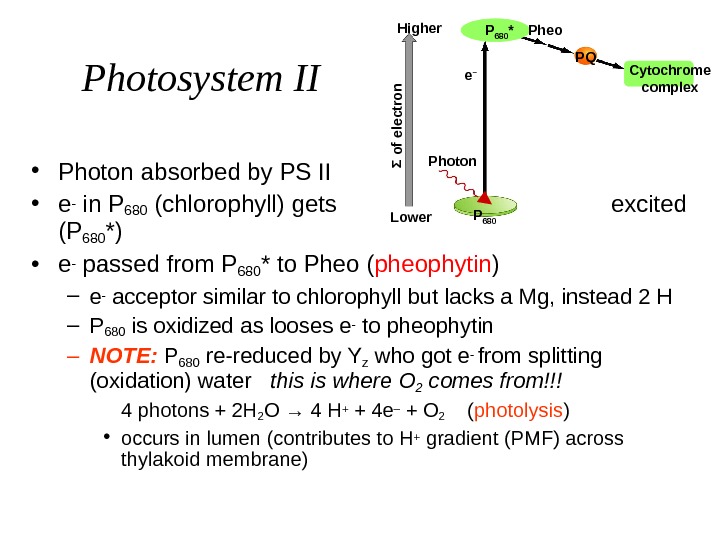




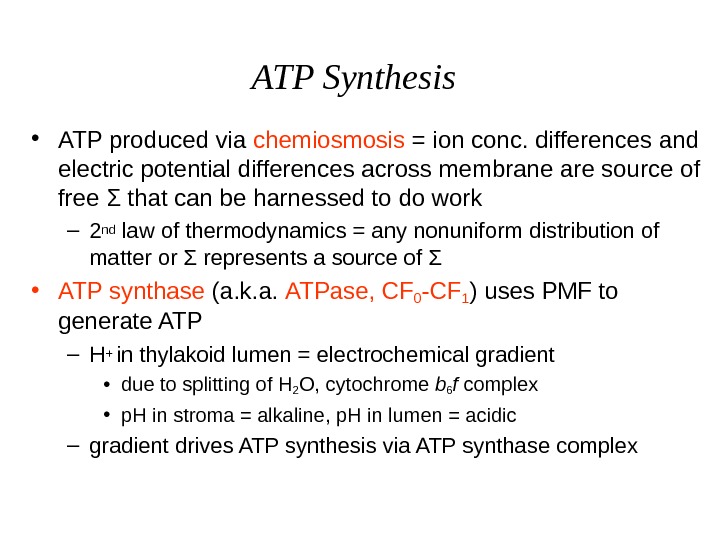


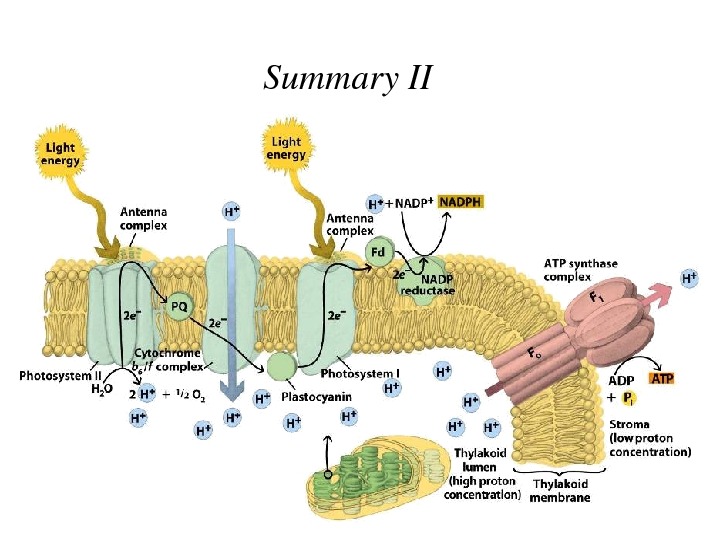
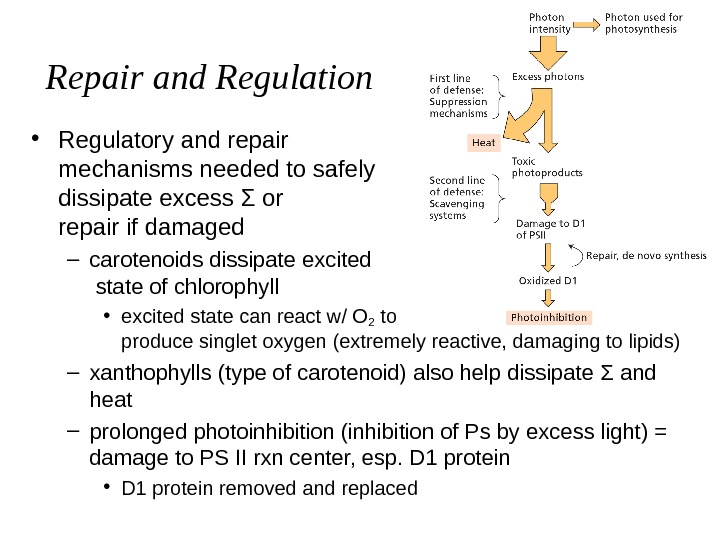
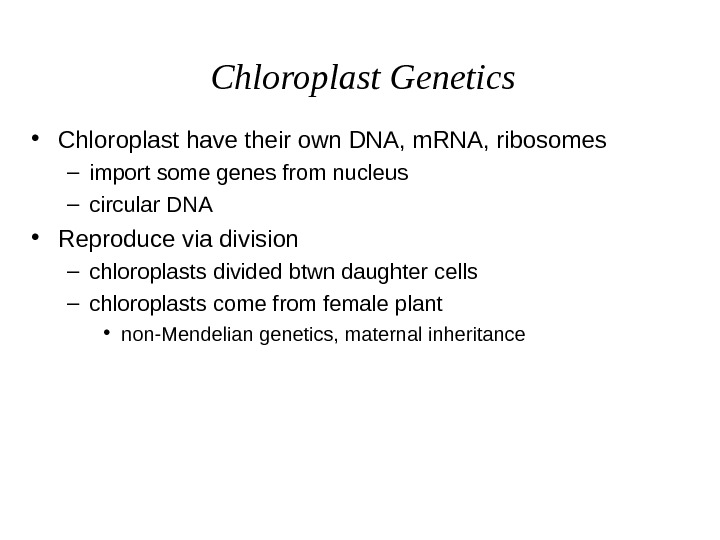

- Размер: 2.6 Mегабайта
- Количество слайдов: 31
Описание презентации Chapter 7 Photosynthesis: The Light Reactions по слайдам
 Chapter 7 Photosynthesis: The Light Reactions
Chapter 7 Photosynthesis: The Light Reactions
 Outline • History and intro • Properties of light and pigments • Light-dependent reactions – photosystem II and I – ATP synthesis • Light-independent reactions – Calvin cycle – Rubisco and photorespiration – CAM and C 4 plants • Physiological and ecological considerations – light – plant anatomy – plant responses – excess light and photoinhibition – greenhouse effect and consequences
Outline • History and intro • Properties of light and pigments • Light-dependent reactions – photosystem II and I – ATP synthesis • Light-independent reactions – Calvin cycle – Rubisco and photorespiration – CAM and C 4 plants • Physiological and ecological considerations – light – plant anatomy – plant responses – excess light and photoinhibition – greenhouse effect and consequences
 History • 1600’s van Helmont — soil alone does not nourish plant • 1700’s Priestley — plants restore air from burning candles • 1700’s Ingenhousz — only green parts of plants restore air, suggests CO 2 split to release O 2 • 1931 van Niel — Ps in purple sulfur bacteria produced S 2 instead of O 2 during Ps thus proposed O 2 released from Ps comes from H 2 O, not CO 2 • 1937 Hill — isolated chloroplasts produced O 2 w/o CO 2 confirming O 2 released from Ps comes from H 2 O, not CO 2 • 1905 Blackman — Ps composed of light-dep. + light-indep. rxns, enzymes involved
History • 1600’s van Helmont — soil alone does not nourish plant • 1700’s Priestley — plants restore air from burning candles • 1700’s Ingenhousz — only green parts of plants restore air, suggests CO 2 split to release O 2 • 1931 van Niel — Ps in purple sulfur bacteria produced S 2 instead of O 2 during Ps thus proposed O 2 released from Ps comes from H 2 O, not CO 2 • 1937 Hill — isolated chloroplasts produced O 2 w/o CO 2 confirming O 2 released from Ps comes from H 2 O, not CO 2 • 1905 Blackman — Ps composed of light-dep. + light-indep. rxns, enzymes involved
 Intro Light Σ H 2 O O 2 Light-dependent reactions Chemical Σ ( ATP , NADPH ) CO 2 Light-independent reactions Chemical Σ (C H 2 O) • Photosynthesis (Ps) = process by which plants convert sunlight into chemical Σ , how Σ enters biosphere – chemical Σ used to convert water and CO 2 into sugars, O 2 is produced as byproduct 6 CO 2 + 6 H 2 O → C 6 H 2 O 6 + 6 O 2 • Consists of light-dependent + light-independent rxns
Intro Light Σ H 2 O O 2 Light-dependent reactions Chemical Σ ( ATP , NADPH ) CO 2 Light-independent reactions Chemical Σ (C H 2 O) • Photosynthesis (Ps) = process by which plants convert sunlight into chemical Σ , how Σ enters biosphere – chemical Σ used to convert water and CO 2 into sugars, O 2 is produced as byproduct 6 CO 2 + 6 H 2 O → C 6 H 2 O 6 + 6 O 2 • Consists of light-dependent + light-independent rxns
 Intro • Light-dependent rxns (a. k. a) light rxns, thylkoid rxns, light-transduction rxns – require light, occur on thylakoid membranes – split water (oxidize water to O 2 ) – produce NADPH, ATP (via PMF) – uses 2 photosystems • Light-independent rxns (a. k. a) dark rxns, carbon fixation rxns, stroma rxns, Calvin cycle – don’t require light, occur in chloroplast stroma – use ATP, NADPH – produce reduced carbon cmpds (i. e. glucose) from CO 2 • Ps primarily occurs in leaf mesophyll cells – mesophyll contains lots of chloroplasts
Intro • Light-dependent rxns (a. k. a) light rxns, thylkoid rxns, light-transduction rxns – require light, occur on thylakoid membranes – split water (oxidize water to O 2 ) – produce NADPH, ATP (via PMF) – uses 2 photosystems • Light-independent rxns (a. k. a) dark rxns, carbon fixation rxns, stroma rxns, Calvin cycle – don’t require light, occur in chloroplast stroma – use ATP, NADPH – produce reduced carbon cmpds (i. e. glucose) from CO 2 • Ps primarily occurs in leaf mesophyll cells – mesophyll contains lots of chloroplasts
 Properties of Light • Light travels in waves – wavelength ( λ ) = distance btwn 2 crests – frequency ( ν ) = # of wave crests that pass a pt in a given time c = λ ν where: c = wave speed, clight = 3. 0 x 108 m s-1 • Light composed of particles of Σ ( photons ) – Σ contained in discrete packets ( quantum ) – Σ of photon inversely proportional to frequency E = h ν where: ν = frequency of light h = Planck’s constant = 6. 626 x 10 -34 J s
Properties of Light • Light travels in waves – wavelength ( λ ) = distance btwn 2 crests – frequency ( ν ) = # of wave crests that pass a pt in a given time c = λ ν where: c = wave speed, clight = 3. 0 x 108 m s-1 • Light composed of particles of Σ ( photons ) – Σ contained in discrete packets ( quantum ) – Σ of photon inversely proportional to frequency E = h ν where: ν = frequency of light h = Planck’s constant = 6. 626 x 10 -34 J s
 Properties of Light • Electromagnetic spectrum = entire range of radiation – visible spectrum = what we can see – each wavelength has particular amnt Σ • shorter wavelength = ↑ Σ (violet) • longer wavelength = ↓ Σ (red) • UV has ↑ Σ , infared has ↓ Σ
Properties of Light • Electromagnetic spectrum = entire range of radiation – visible spectrum = what we can see – each wavelength has particular amnt Σ • shorter wavelength = ↑ Σ (violet) • longer wavelength = ↓ Σ (red) • UV has ↑ Σ , infared has ↓ Σ
 A bsorption. Chlorophyll a most effective 400 600500 700 Chlorophyll b Carotenoids Wavelength (nm)Properties of Light • Absorption spectrum = amount of light Σ absorbed by a substance as a func. of wavelength – chlorophyll a absorbs blue (430 nm) and red (660 nm) portion of spectrum – other pigments extend Ps useful portion of spectrum
A bsorption. Chlorophyll a most effective 400 600500 700 Chlorophyll b Carotenoids Wavelength (nm)Properties of Light • Absorption spectrum = amount of light Σ absorbed by a substance as a func. of wavelength – chlorophyll a absorbs blue (430 nm) and red (660 nm) portion of spectrum – other pigments extend Ps useful portion of spectrum
 Quantum Efficiency vs Energy Efficiency • Quantum efficiency = fraction of absorbed photons that engage in photochemistry = 100% – energy efficiency = fraction of absorbed Σ that is stored as chemical products = 27% • other 73% converted to heat • of the 27%, most is used for R m
Quantum Efficiency vs Energy Efficiency • Quantum efficiency = fraction of absorbed photons that engage in photochemistry = 100% – energy efficiency = fraction of absorbed Σ that is stored as chemical products = 27% • other 73% converted to heat • of the 27%, most is used for R m
 Pigments • Pigment = substance that absorbs photons of light – photon hits pigment it can be absorbed, transmitted or reflected – we see transmitted or reflected – pigments absorb specific wavelengths of light = absorption spectrum • pigment absorbs all wavelengths in visible spectrum = black • pigment absorbs green and blue wavelengths but transmits or reflects red wavelengths = red (750 nm) • chlorophyll = reflects green, absorbs violet, blue and red • Action spectrum = effectiveness of wavelengths
Pigments • Pigment = substance that absorbs photons of light – photon hits pigment it can be absorbed, transmitted or reflected – we see transmitted or reflected – pigments absorb specific wavelengths of light = absorption spectrum • pigment absorbs all wavelengths in visible spectrum = black • pigment absorbs green and blue wavelengths but transmits or reflects red wavelengths = red (750 nm) • chlorophyll = reflects green, absorbs violet, blue and red • Action spectrum = effectiveness of wavelengths
 Pigments • When photon hits pigment, e- bumped to higher orbital ( ↑ potential Σ b/c further from nucleus) ( excited state ) – once e — in higher orbital (unstable) it has 4 fates • re-emit photon and fall back to original position ( florescence and heat ) • convert Σ to heat • transfer Σ to another chlorophyll until reaches reaction center (a. k. a. resonance energy transfer ) • transfer Σ to other chemical rxns in ETS e –e – Photons 0 1 2 Energy state of electrons in chlorophyll Blue photons excite e — to higher level b/c more Σ Red photons excite e – to high level Photon Chlorophyll molecules Rxn center
Pigments • When photon hits pigment, e- bumped to higher orbital ( ↑ potential Σ b/c further from nucleus) ( excited state ) – once e — in higher orbital (unstable) it has 4 fates • re-emit photon and fall back to original position ( florescence and heat ) • convert Σ to heat • transfer Σ to another chlorophyll until reaches reaction center (a. k. a. resonance energy transfer ) • transfer Σ to other chemical rxns in ETS e –e – Photons 0 1 2 Energy state of electrons in chlorophyll Blue photons excite e — to higher level b/c more Σ Red photons excite e – to high level Photon Chlorophyll molecules Rxn center
 Pigments • All Ps pigments found in chloroplast – primary photosynthetic pigment = chlorophyll a • must have chl. a • ring structure w/ Mg • similar to hemoglobin • hydrophobic tail embedded in thylakoid membrane – chl. b , carotenoids and phycobilins are accessory pigments • accessory pigments = not directly involved in Σ transduction, pass Σ to chl. a which transforms it to chemical Σ , extend useful spectrum, antioxidant func. • carotenoids = red/orange/yellow, embedded in thylakoid, fall color – 2 types carotenoids — carotene and xanthophyll
Pigments • All Ps pigments found in chloroplast – primary photosynthetic pigment = chlorophyll a • must have chl. a • ring structure w/ Mg • similar to hemoglobin • hydrophobic tail embedded in thylakoid membrane – chl. b , carotenoids and phycobilins are accessory pigments • accessory pigments = not directly involved in Σ transduction, pass Σ to chl. a which transforms it to chemical Σ , extend useful spectrum, antioxidant func. • carotenoids = red/orange/yellow, embedded in thylakoid, fall color – 2 types carotenoids — carotene and xanthophyll
 Anatomy • Ps occurs in chloroplast – double-membrane, DNA, RNA, ribosomes – extensive 3 rd membrane = thylakoid membrane • chlorophyll embedded (light-dep. rxns) – stroma (light-indep. rxns) – grana lamellae (PS II) – stroma lamellae (PS I) – granum – lumen
Anatomy • Ps occurs in chloroplast – double-membrane, DNA, RNA, ribosomes – extensive 3 rd membrane = thylakoid membrane • chlorophyll embedded (light-dep. rxns) – stroma (light-indep. rxns) – grana lamellae (PS II) – stroma lamellae (PS I) – granum – lumen
 Overview of Photosynthesis • 2 main events of Ps (+50 rxn steps in Ps discovered) – light-dependent rxns • light Σ transferred to chemical bond in ADP and reduction of NADP + , forming ATP and NADPH • thylakoid membranes – light-independent rxns • ATP used to link CO 2 to organic molecule • NADPH used to reduce C to simple sugar • carbon or CO 2 fixation = conversion of CO 2 into organic cmpds • stroma
Overview of Photosynthesis • 2 main events of Ps (+50 rxn steps in Ps discovered) – light-dependent rxns • light Σ transferred to chemical bond in ADP and reduction of NADP + , forming ATP and NADPH • thylakoid membranes – light-independent rxns • ATP used to link CO 2 to organic molecule • NADPH used to reduce C to simple sugar • carbon or CO 2 fixation = conversion of CO 2 into organic cmpds • stroma
 Antenna Complex and Reaction Center • Most pigments serve as antenna – antenna collect light and transfer its Σ to reaction center • antenna complex = group of antenna molecules • means of increasing efficiency • integral proteins – reaction center complex = Σ is stored by transferring e- from chlorophyll to e- acceptor (REDOX rxns) • e — boosted to higher orbital • integral proteins
Antenna Complex and Reaction Center • Most pigments serve as antenna – antenna collect light and transfer its Σ to reaction center • antenna complex = group of antenna molecules • means of increasing efficiency • integral proteins – reaction center complex = Σ is stored by transferring e- from chlorophyll to e- acceptor (REDOX rxns) • e — boosted to higher orbital • integral proteins
 Photosystems I and II • Enhancement effect = Ps rate greater w/ red and far-red light together than w/ each separate – due to 2 photochemical complexes (photosystem I and II) – work in conjuction, independent antenna and rxn centers – linked by electron transport chain • e- flow = H 2 O → PS II → PS I → NADP+ (Z scheme) • PSII chl. a = P 680 (red) vs PSI chl. a = P 700 (far-red)
Photosystems I and II • Enhancement effect = Ps rate greater w/ red and far-red light together than w/ each separate – due to 2 photochemical complexes (photosystem I and II) – work in conjuction, independent antenna and rxn centers – linked by electron transport chain • e- flow = H 2 O → PS II → PS I → NADP+ (Z scheme) • PSII chl. a = P 680 (red) vs PSI chl. a = P 700 (far-red)
 Photosystems I and II • PS I and II spatially separated on thylakoid membrane – PS II on grana lamellae – PS I on stroma lamellae – ETC that connects PSII to PSI found throughout – PSII produces • 4 photons + 2 H 2 O → 4 H + + 4 e – + O 2 ( photolysis ) – H+ released in lumen (H + gradient) – increases efficiency b/c pool of reducers vs having to associate w/ single PS
Photosystems I and II • PS I and II spatially separated on thylakoid membrane – PS II on grana lamellae – PS I on stroma lamellae – ETC that connects PSII to PSI found throughout – PSII produces • 4 photons + 2 H 2 O → 4 H + + 4 e – + O 2 ( photolysis ) – H+ released in lumen (H + gradient) – increases efficiency b/c pool of reducers vs having to associate w/ single PS
 ET
ET

 Photosystem II • Photon absorbed by PS II • e- in P 680 (chlorophyll) gets excited (P 680 *) • e — passed from P 680 * to Pheo ( pheophytin ) – e — acceptor similar to chlorophyll but lacks a Mg, instead 2 H – P 680 is oxidized as looses e- to pheophytin – NOTE: P 680 re-reduced by Yz who got e- from splitting (oxidation) water this is where O 2 comes from!!! 4 photons + 2 H 2 O → 4 H + + 4 e – + O 2 ( photolysis ) • occurs in lumen (contributes to H + gradient (PMF) across thylakoid membrane) Higher Lower Σ of electron P 680 Photon e – Pheo PQ Cytochrome complex. P 680 *
Photosystem II • Photon absorbed by PS II • e- in P 680 (chlorophyll) gets excited (P 680 *) • e — passed from P 680 * to Pheo ( pheophytin ) – e — acceptor similar to chlorophyll but lacks a Mg, instead 2 H – P 680 is oxidized as looses e- to pheophytin – NOTE: P 680 re-reduced by Yz who got e- from splitting (oxidation) water this is where O 2 comes from!!! 4 photons + 2 H 2 O → 4 H + + 4 e – + O 2 ( photolysis ) • occurs in lumen (contributes to H + gradient (PMF) across thylakoid membrane) Higher Lower Σ of electron P 680 Photon e – Pheo PQ Cytochrome complex. P 680 *
 Photosystem II • e- passed from Pheo to QA and Q B ( plastoquinones/PQ ) – as e — passed by QA and QB , H + pumped into thylakoid lumen thereby creating H + gradient (PMF) across thylakoid membrane • e — passed from PQ to cytochrome b 6 f complex – large multisubunit protein w/ heme groups • e — passed from b 6 f complex to plastocyanin ( PC ) – protein w/ copper • e — passed from PC to P 700 (PS II) H + H + H + 2 e – H +2 e – P 680 Pheo Thylakoidlumen (lowp. H) H + Cytochrome complex PQ PQ
Photosystem II • e- passed from Pheo to QA and Q B ( plastoquinones/PQ ) – as e — passed by QA and QB , H + pumped into thylakoid lumen thereby creating H + gradient (PMF) across thylakoid membrane • e — passed from PQ to cytochrome b 6 f complex – large multisubunit protein w/ heme groups • e — passed from b 6 f complex to plastocyanin ( PC ) – protein w/ copper • e — passed from PC to P 700 (PS II) H + H + H + 2 e – H +2 e – P 680 Pheo Thylakoidlumen (lowp. H) H + Cytochrome complex PQ PQ
 Photosystem I • e — passed to P 700 (reduced) from PC in PS II • Photon absorbed by reduced P 700 • e — in P 700 gets excited (P 700 *) • e — passed from P 700 * to A 0 (chlorophyll? ) to A 1 (phylloquinone, a. k. a. vitamin A) • e — passed from A 1 to Fe. S x to Fe. S A to Fe. S B (Fe-S proteins) • e — passed from Fe. S B to Fd (ferredoxin) (Fe-S protein) • Ferredoxin/NADP + reductase (FNR) txf e — and H + to NADP + to form NADPH – NADPH highly reduced, used to reduce CO 2 in Calvin Cycle – occurs in stromaΣ of electron Higher Lower Photon P 700 e – ETC NADPHNADP + + H + Fd. P 700 *
Photosystem I • e — passed to P 700 (reduced) from PC in PS II • Photon absorbed by reduced P 700 • e — in P 700 gets excited (P 700 *) • e — passed from P 700 * to A 0 (chlorophyll? ) to A 1 (phylloquinone, a. k. a. vitamin A) • e — passed from A 1 to Fe. S x to Fe. S A to Fe. S B (Fe-S proteins) • e — passed from Fe. S B to Fd (ferredoxin) (Fe-S protein) • Ferredoxin/NADP + reductase (FNR) txf e — and H + to NADP + to form NADPH – NADPH highly reduced, used to reduce CO 2 in Calvin Cycle – occurs in stromaΣ of electron Higher Lower Photon P 700 e – ETC NADPHNADP + + H + Fd. P 700 *
 Noncyclic Photophosphorylation • Z-scheme used to describe how PS I and II interact • Noncyclic photophosphorylation (uses light to produce ATP) – what we’ve covered so far – 2 photons from each photosystem = 1 NADPH and 1 O – products go to Calvin Cycle • H 2 O + NADP + → NADPH + + ½ O 2 • 6 e — = 6 ATP + 6 NADPH
Noncyclic Photophosphorylation • Z-scheme used to describe how PS I and II interact • Noncyclic photophosphorylation (uses light to produce ATP) – what we’ve covered so far – 2 photons from each photosystem = 1 NADPH and 1 O – products go to Calvin Cycle • H 2 O + NADP + → NADPH + + ½ O 2 • 6 e — = 6 ATP + 6 NADPH
 Cyclic Photophosphorylation • Cyclic photophosphorylation when extra ATP needed – PS I donates e- to back to PS II resulting in production of additional ATP (no NADPH) • e — txf via PQ – PS II generates ATP only – PS I generates NADPH
Cyclic Photophosphorylation • Cyclic photophosphorylation when extra ATP needed – PS I donates e- to back to PS II resulting in production of additional ATP (no NADPH) • e — txf via PQ – PS II generates ATP only – PS I generates NADPH
 ATP Synthesis • ATP produced via chemiosmosis = ion conc. differences and electric potential differences across membrane are source of free Σ that can be harnessed to do work – 2 nd law of thermodynamics = any nonuniform distribution of matter or Σ represents a source of Σ • ATP synthase (a. k. a. ATPase, CF 0 -CF 1 ) uses PMF to generate ATP – H + in thylakoid lumen = electrochemical gradient • due to splitting of H 2 O, cytochrome b 6 f complex • p. H in stroma = alkaline, p. H in lumen = acidic – gradient drives ATP synthesis via ATP synthase complex
ATP Synthesis • ATP produced via chemiosmosis = ion conc. differences and electric potential differences across membrane are source of free Σ that can be harnessed to do work – 2 nd law of thermodynamics = any nonuniform distribution of matter or Σ represents a source of Σ • ATP synthase (a. k. a. ATPase, CF 0 -CF 1 ) uses PMF to generate ATP – H + in thylakoid lumen = electrochemical gradient • due to splitting of H 2 O, cytochrome b 6 f complex • p. H in stroma = alkaline, p. H in lumen = acidic – gradient drives ATP synthesis via ATP synthase complex
 ATP Synthesis • ATP synthase consists of hydrophobic portion CF 0 (in membrane) and CF 1 (sticks out in stroma) – found on stroma lamellae and edge of grana of thylakoid membrane – CF 0 contains channel which H+ pass, • rotates along w/ internal stalk – CF 1 where ATP synthesized – when H + pass potential energy converted to kinetic – kinetic Σ converted to chemical bond • 4 H + translocated per ATP
ATP Synthesis • ATP synthase consists of hydrophobic portion CF 0 (in membrane) and CF 1 (sticks out in stroma) – found on stroma lamellae and edge of grana of thylakoid membrane – CF 0 contains channel which H+ pass, • rotates along w/ internal stalk – CF 1 where ATP synthesized – when H + pass potential energy converted to kinetic – kinetic Σ converted to chemical bond • 4 H + translocated per ATP
 Summary • 4 major protein complexes – PS II oxidizes H 2 O, releases H + into lumen – b 6 f complex pumps additional H + into lumen – PS I reduces NADP + to NADPH – ATP synthase produces ATP – initial acceptor? – final donor? ?
Summary • 4 major protein complexes – PS II oxidizes H 2 O, releases H + into lumen – b 6 f complex pumps additional H + into lumen – PS I reduces NADP + to NADPH – ATP synthase produces ATP – initial acceptor? – final donor? ?
 Summary. II
Summary. II
 Repair and Regulation • Regulatory and repair mechanisms needed to safely dissipate excess Σ or repair if damaged – carotenoids dissipate excited state of chlorophyll • excited state can react w/ O 2 to produce singlet oxygen (extremely reactive, damaging to lipids) – xanthophylls (type of carotenoid) also help dissipate Σ and heat – prolonged photoinhibition (inhibition of Ps by excess light) = damage to PS II rxn center, esp. D 1 protein • D 1 protein removed and replaced
Repair and Regulation • Regulatory and repair mechanisms needed to safely dissipate excess Σ or repair if damaged – carotenoids dissipate excited state of chlorophyll • excited state can react w/ O 2 to produce singlet oxygen (extremely reactive, damaging to lipids) – xanthophylls (type of carotenoid) also help dissipate Σ and heat – prolonged photoinhibition (inhibition of Ps by excess light) = damage to PS II rxn center, esp. D 1 protein • D 1 protein removed and replaced
 Chloroplast Genetics • Chloroplast have their own DNA, m. RNA, ribosomes – import some genes from nucleus – circular DNA • Reproduce via division – chloroplasts divided btwn daughter cells – chloroplasts come from female plant • non-Mendelian genetics, maternal inheritance
Chloroplast Genetics • Chloroplast have their own DNA, m. RNA, ribosomes – import some genes from nucleus – circular DNA • Reproduce via division – chloroplasts divided btwn daughter cells – chloroplasts come from female plant • non-Mendelian genetics, maternal inheritance
 Endosymbiosis • Chloroplast is semiautonomous – own DNA, m. RNA, ribosomes – descendant of symbiotic relationship btwn cyanobacteria and nonphotosynthetic eukaryotic cell (endosymbiosis) – genetic information lost thus needs host
Endosymbiosis • Chloroplast is semiautonomous – own DNA, m. RNA, ribosomes – descendant of symbiotic relationship btwn cyanobacteria and nonphotosynthetic eukaryotic cell (endosymbiosis) – genetic information lost thus needs host

